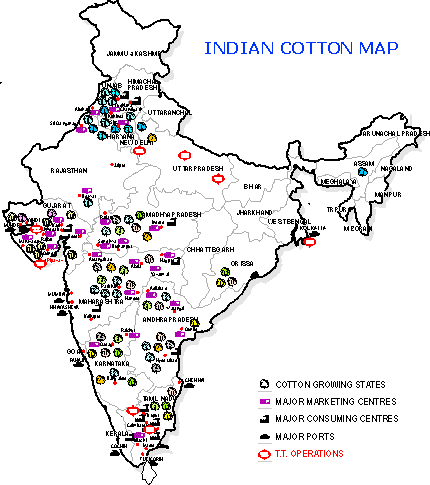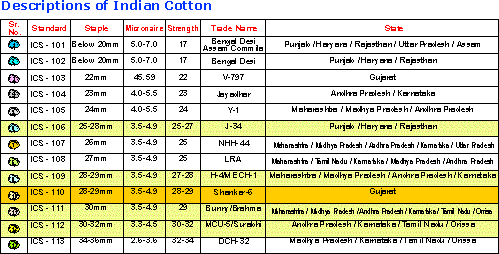Cotton is a natural fibre. The comfort of Cotton fabrics is unique as compared to the fabric made out of synthetic fibers.
Indian Cotton

Cotton is being grown in India for more than 5000 years. Three centuries back its cotton muslin used to sell in Europe for the weight of Gold. Presently the Indian cotton industry is at a very important threshold. The world has started recognising the quality of Indian raw cotton fibre and is buying more and more fibre from India. The industry has taken rapid steps by introducing upgraded technology ginning machines, adopting BT seeds, employing better picking and ginning practices. This lead improvement in controling trash, contamination, and improving consistency and uniformity.
From 2004-2005 crop India has seen phenomenal growth in productivity terms due to the use of BT seeds and good monsoon. Despite this, India’s productivity per hectare is amongst the lowest in the world which makes it the country with highest acreage but still 2nd largest producer. This leaves it with a major scope for expansion and increased importance in the cotton world. Crop is expected to be 5.6 million tons in 2008-09 i.e. 33 million bales of 170 kgs. (This would make it the 2nd largest producer in the world after China.) India is expected to export 10 million bales in 2008-09.
India is the Second biggest producer of cotton next to China, Second biggest consumer after China, and also second biggest cotton exporter next to USA. India has also strongly moved into organic cotton and is the second largest producer after Turkey in the world.
How Do We Ensure Quality?
Kapas is hand picked, fibre is not damaged

- Employ selectors in various cotton stations for kapas (seed cotton) buying.
- Kapas is checked by visual graders, hand classers and tested by electronic machines in lab to determine post ginning fibre attributes.
- Moisture is controlled at every stage.
- Ginning is done in “TMC” approved factories that means modern equipments and automatic
- Various measures are taken to avoid contamination.
- Only cloth brooms are used for cleaning.
- Kapas and final cotton is kept on cemented floor and not on mud/dust.
- Human handling is minimised during ginning.
- Workers tie their hair with cloth to avoid hair strands.
- Workers remove visible contaminats by hand picking.
 |
 |
 |
 |
 |
 |
 |
 |
Have in-house state of the art laboratories equipped with all types of machinery for grading and testing of cotton. It has a uster HVI spectrum equipment & trash analyser.
Who Are We?
- 60 years old vertically integrated textile group.
- T T Brand is a household name with both retail consumers and industrial buyers.
- Have Three, ISO 9002 certified spinning mills.
- Doing both own and contract ginning of various types of raw cotton.
- Manufacturing garments all across India (multi-location).
- Has ultra modern Knitting units in North and South India.
- Managed and run by professional persons-MBAs, CAs, Textile Engineers.
- Good corporate and brand image.

With expectations of increase in cotton crop size in India we could measure the opportunity and make suggestions to our overseas yarn importers which happened to be largely spinners themselves. We suggested that they can use Indian Cotton competitively. They had fears about quality of Indian Cotton. We reassured them about features of Indian Cotton, Shankar-6 in particular pointing out that if our yarn spun out of Shankar Cotton is acceptable to them and other importers worldwide, the yarn spun by them by importing Cotton from India would be good for them as well. In the year 2004 we could break the ice in a pioneering manner and from 2005 we had big bang in the International market. Gradually in the subsequent three years India has earned the status of the second biggest exporter of cotton in the world next only to U.S.
Our philosophy:
To create value for the customer in terms of better
product, better quality, better price, better delivery.
T T COTTON, HONEST COTTON
Why Indian Cotton?
| Type | Pros | Cons |
| S6 | Excellent Grade, absorption, lusture and Strength | Contamination |
| MCU5 | Good Staple Length, lustre, absoption and strength | High Contamination |
| DCH32 | Staple Length, Strength | Low micronaire, relatively higher trash |
| Mech 1 | Cheaper than S-6 | Maginally low on all parameters against S-6 |
| J34 | Good Dye absorption, high mic/maturity | High Trash |
| H4 | Price lowest in its length peers | Low uniformity / grade |
| Bunny | Price Lowest in its length peers | Grade lower than MCU 5 |
| LRA | Trash lower than J-34 | Mic variance high, grade lower than J34 |
| V 797 | Inspite of high trash, final yarn good as it falls out good lustre |
Why T T Cotton is Different?
T T introduces dry pack cleanest and purest cotton never offered before can offer Indian growths : Shankar 6 and Mech-1 with special selection.
- Dry Pack moisture less than 5% against 9-15% in competing Indian growths.
- Contaminants Cleared Electronically by Vision Shield at extra cost.
- Low trash below 2%
- Best Selected Lint with low Short fibers content.
- Highest Yarn Realisation more than 76% in case of Combed Yarn (against standard 68% while using non T T Cotton from India)
- Bale Management offered at nominal extra cost.
- New safe packing with modern automatic baling.
Special Offers
- Dry pack cotton
- Vision shield cleared cotton bales-low contamination
- Bale Management by making available test data for every bale
- Pioneer in Instrumental Trading and standardisation
- Organic Cotton
Just book your years’ cotton requirement with T T Cotton and relax. You do not need any efforts thereafter. Your profit spinning begins with arrival of T T Cotton in your mill.Moisture above 7% in Cotton you buy, steals your profits even before cotton arrives at your mill.
Please don’t tell this secret to your fellow spinners.

